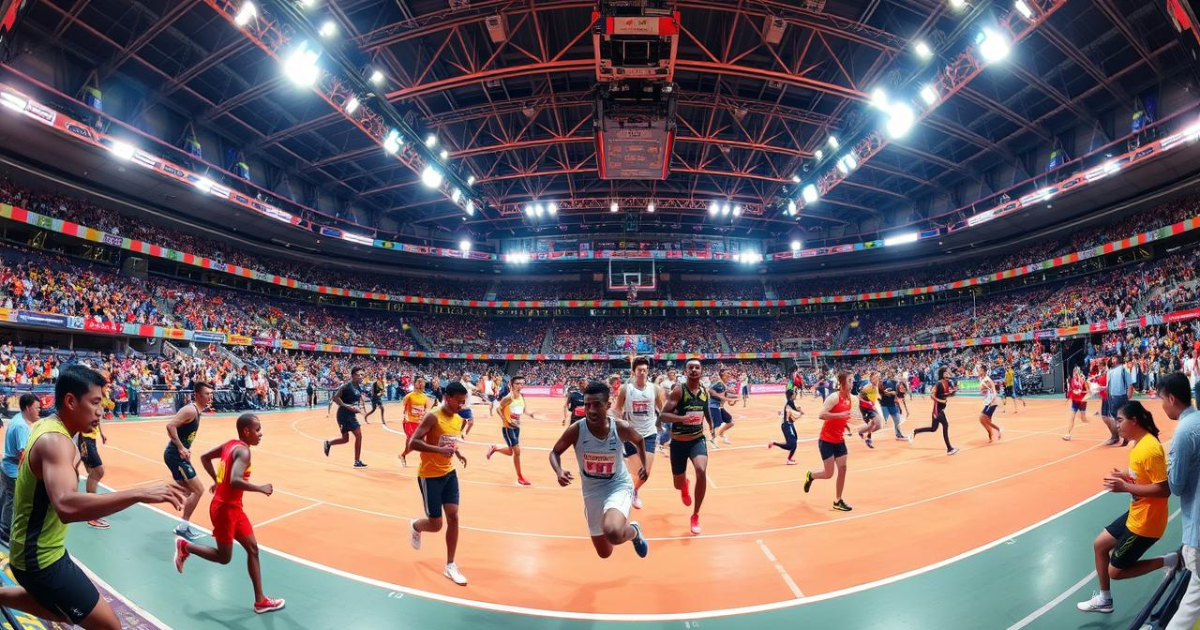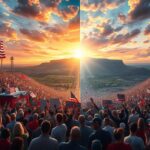Imagine taking a single photo that shows the full excitement of a big sports event. This is what panorama sport photography does. It lets us see the action, the fans, and the venue all in one stunning picture.
This type of photography is a unique art that makes sports more exciting for fans and media. By using the latest cameras and techniques, photographers capture the real spirit of sports. It’s something regular photos can’t do.
Key Takeaways
- Panorama sport photography uses wide-angle shots to show the whole scene of sports events.
- It lets photographers capture the action and the setting, making the scene complete.
- To get great shots, photographers need special gear and know-how to capture the energy of sports.
- The panoramic view creates amazing images that pull you right into the action.
- Panorama sport photography is a unique art that makes watching sports even more thrilling.
What is Panorama Sport Photography?
Panorama sport photography captures the full scope of athletic events. It uses wide-angle, panoramic techniques. This way, photographers show not just the action but also the setting and context of the event.
Capturing Dynamic Moments in Sports
Photographers need to be quick and precise to capture the action. They adjust their camera settings to freeze the moment. They aim to show the whole scene in one wide-angle shot.
This creates immersive images that feel like you’re right in the action.
Techniques and Gear for Panoramic Sports Shots
Specialized gear like wide-angle lenses and tripods are key. Photographers also need to know how to frame the scene. They use these tools to make images that show the sport’s energy and excitement.
| Gear for Panorama Sport Photography | Recommended Techniques |
|---|---|
|
|
With the right techniques and gear, photographers can make stunning images. These images show the full scope of sports events. They captivate viewers and offer a unique view of sports.
The Significance of Panorama Sport Photography
Panorama sport photography is very important in sports media and storytelling. It captures the full scene of athletic events. This gives a unique view that goes beyond regular shots.
These panoramic photos make viewers feel like they’re right in the action. They show the scale, energy, and atmosphere of the event.
The value of panorama sport photography is huge. It celebrates athletic wins, documents sports history, and excites fans. These images are great for sports groups, media, and fans. They show the whole picture of the event.
Also, the panoramic style lets photographers show the beauty and drama of sports. The impact of panoramic sports images is huge. They bring viewers into the action, making them appreciate the athletes and the sport more.
| Significance of Panorama Sport Photography | Impact of Wide-Angle Sports Photography |
|---|---|
| Commemorates and celebrates athletic achievements | Offers a complete visual view of the sporting event |
| Documents the history of the sport | Brings viewers into the heart of the action |
| Generates excitement and interest in sporting events | Helps fans appreciate and connect with athletes and sports |
In summary, the significance of panorama sport photography is huge. It gives a full, immersive, and artistic view of sports. This makes it very valuable for sports media, groups, and fans.
Essential Gear for Panorama Sport Photography
To get great panorama sport photos, you need the right camera gear and accessories. A DSLR or mirrorless camera with manual controls is key. It lets you adjust settings fast to catch the action.
For panoramic shots, wide-angle zoom lenses are best. Look for ones in the 16-35mm or 24-70mm range. They let you capture the whole scene in one photo.
Cameras and Lenses for Panoramic Shots
Rod Planck, a top panoramic sports photographer, uses lenses from 60mm to 135mm. He suggests lenses between 50mm and 300mm for great shots. For seamless panoramas, use a 25% overlap with 50mm lenses or longer. For shorter lenses, aim for a 50% overlap.
Planck also stresses the need for manual exposure settings. He uses f/16 and f/22 for a deep depth of field. Keeping white balance consistent and focusing to infinity is also key. Avoid changing exposure between frames for the best results.
Accessories for Stability and Lighting
A sturdy tripod or monopod is vital for stable shots. Planck likes tripods with a built-in bubble level and a ball head. This setup makes smooth camera movement easy. Mount the camera vertically to capture overlapping scenes efficiently.
For good lighting, an external flash or lighting modifiers might be needed. They help freeze the action and keep image quality high. Specialized panoramic head attachments can also help stitch images together for a wider view.
Mastering Camera Settings for Action Shots
To get great panorama sport photos, you need to know your camera well. A fast shutter speed is key, usually 1/1000 second or quicker. This stops the athletes from blurring.
Continuous autofocus, or “AI Servo” mode, keeps your camera on the moving subjects. This way, you get sharp photos of the action. You can also try pre-focusing techniques to focus on where the action will be.
Shutter Speed and Autofocus Techniques
Sports photography needs quick shutter speeds to freeze the action. You should use at least 1/500th of a second to avoid blur. Knowing the sport helps choose the right gear, like lenses and shutter speeds.
- Recommended shutter speed: At least 1/500th of a second to freeze action without blur.
- Aperture settings: Aim for around f/2.8 or wider for better light intake in low-light sports scenarios.
- Lenses for night sports: 70-200mm lens with an aperture of f/2.8 or wider.
- Stabilization gear: Tripods and stabilization equipment are essential for maintaining image sharpness at slow shutter speeds.
By getting good at these camera settings and autofocus methods, you can take amazing sports photos. These photos show the excitement and intensity of the game.
Composition Tips for Panorama Sport Photography
Capturing the essence of a dynamic sporting event through panorama photography requires careful attention to composition. As you frame your wide-angle shots, consider the following tips to elevate your panoramic sports imagery:
- Positioning and Framing: Experiment with different camera angles, shooting from low or high vantage points to create visually striking compositions. Ensure the athletes, playing field, and surrounding environment are included within the frame to convey the full scope of the scene.
- Horizon Line Placement: Pay close attention to the positioning of the horizon line, as it can significantly impact the balance and overall aesthetic of your panoramic shots. Experiment with different horizon line placements to find the most compelling composition.
- Leading Lines: Utilize natural or architectural elements within the scene, such as the sidelines, stadium seating, or spectator walkways, to guide the viewer’s eye through the frame and enhance the sense of depth and scale.
- Contextual Elements: Incorporate elements like spectators, team benches, or distinctive stadium features to provide additional context and immerse the viewer in the sporting event’s atmosphere.
By applying these composition tips for panorama sport photography, you can capture dynamic, visually engaging panoramic shots that showcase the full breadth and energy of the athletic action.
| Aspect | Recommendation |
|---|---|
| Overlap between frames | About 40% |
| Additional coverage beyond desired panorama | 30% |
| Resolution of final panorama | Nearly 110MP (13198 x 8301) |
| Time spent in the field | Additional 3 minutes |
| Time spent on processing | Additional 3 minutes |
By incorporating these panoramic sports photography composition techniques and considerations, you can elevate your framing and positioning for panoramic sports shots, creating visually stunning and immersive panoramic sports imagery.
Capturing Emotion and Storytelling
As panorama sport photographers, you do more than just take pictures. You aim to show the emotion, drama, and human stories of sports. By anticipating key moments, like game-winning plays, you capture the intensity and passion of the game.
Adding environmental portraits and behind-the-scenes shots gives a deeper look at athletes and the event. These images make sports more relatable and share personal stories.
Anticipating Key Moments
You know how important it is to anticipate and track key moments in sports. By watching the game and reading athlete’s expressions, you’re ready to capture decisive, game-changing instants. These moments will grab your audience’s attention.
Environmental Portraits and Behind-the-Scenes
Your skill in capturing environmental portraits and behind-the-scenes moments adds depth to your photos. These images let viewers connect with the human element of the sport. They appreciate the athletes, coaches, and staff more.
“The ‘Migrant Mother’ captured by Dorothea Lange during the Great Depression received widespread attention and led to the U.S. government sending 20,000 pounds of food aid.”
By mixing the game’s action with personal stories, you create a rich and captivating visual narrative. This is the heart of panorama sport photography.
Editing and Post-Processing Panorama Sport Images
Capturing the perfect panorama sport photo is just the start. Post-processing and image editing are key to making it even better. Luminar Neo offers smart features and advanced tools for this purpose.
Editing software lets you tweak exposure, color, and add filters. It brings out the drama and emotion in panoramic shots. You can also stitch images together for a wider view. Experts say to overlap images by 30% for the best results.
A case study showed stitching 11 portrait photos into a panorama took about 7 minutes in Photoshop. But, processing time can vary based on your computer.
To make sunset effects pop, a 30% warm color temperature adjustment was used. Lightroom’s Graduated and Radial filters can also fine-tune your images.
“By mastering post-processing techniques, photographers can elevate their panorama sport images and ensure they effectively convey the energy, intensity, and scale of the sporting event.”
The article highlights the value of stitching images for sports scenes. It encourages creativity and flexibility in photography. With the right tools and skills, photographers can make stunning images that capture the essence of sports.
panorama sport: Capturing Athletic Action in Full View
Panorama sport photography lets you see the whole picture of athletic events. It uses wide-angle shots to make images that pull you into the action. This way, you feel like you’re right there with the athletes.
This type of photography captures the movement of players and the setting around them. panorama sport photography gives a fresh view of sports. It uses special equipment and techniques to make images that show the excitement and drama of sports.
New tech is changing how we see sports through panorama sport photography. Tools like Pixellot’s AI cameras and Veo’s video analysis tools make it easier to get great shots. They help make sports coverage better and more affordable.
“Panorama sport photography is a powerful genre that allows us to immerse the viewer in the dynamic world of athletics, capturing the full energy and emotion of the sporting experience.”
These new tools track players and events, and give detailed stats. They help sports photographers create amazing panorama sport photography. As tech keeps improving, wide-angle sports photography will keep drawing in fans.
Sharing and Showcasing Your Panorama Sport Photos
After taking your amazing panorama sport photos, it’s time to share them. Online platforms and social media are great for this. Sites like Instagram, Facebook, and photography websites let you post your photos. You can meet other fans, find new clients, or get noticed by media.
Setting up online photo galleries or portfolios is also a good idea. They let you show off your best work and share the stories behind your photos. By using digital platforms, you can inspire others, celebrate sports wins, and show off your skills in panorama sport photography.
Online Platforms and Social Media
Posting your panorama sport photos online can make them more visible. Here are some places to consider:
- Instagram: Use its visual style to show off your panoramic sports shots and connect with photography fans.
- Facebook: Make a page or album for your panorama sport photography. It helps you reach more people.
- Photography-focused websites: Sites like 500px or Flickr are perfect for showing off your panoramic sports photos and meeting other photographers.
Use the right hashtags and captions to help people find your photos. Also, talk to your followers by answering comments and sharing what goes on behind the scenes.
“Sharing your panorama sport photos on online platforms can help you inspire others, celebrate athletic achievements, and establish yourself as a skilled practitioner in the genre.”
The Future of Panorama Sport Photography
Technology keeps getting better, and so does panorama sport photography. New tools like high-resolution cameras and advanced software will change the game. These tools will make panorama sport images more detailed and immersive, showing the full excitement of sports.
Virtual and augmented reality are also on the rise. They might bring a new level to panoramic sports photography. Fans could feel like they’re right in the action. As sports media gets more popular, panorama photography will be key in showing off sports achievements.
Emerging Technologies and Trends
The future of panorama sport photography is bright thanks to new tech and trends:
- High-resolution cameras can take stunning panoramic shots with amazing detail.
- New software makes it easier to stitch images together for seamless panoramas. These can even be printed in huge sizes.
- Special camera rigs and robots let photographers move freely and capture unique shots.
- Virtual and augmented reality are making it possible to experience sports in a whole new way.
With these emerging technologies and trends, sports fans and media will see incredible images. These images will show the true spirit of sports.
Conclusion
Panorama sport photography is a captivating genre. It lets photographers show the full scope of athletic events. Wide-angle and panoramic techniques create stunning images that pull the viewer into the action.
These images don’t just show the competition. They also highlight the environment and the context of the sporting event. This makes the viewer feel like they’re right there, experiencing it all.
Photographers use special gear and settings to capture these moments. They focus on the athlete’s skill, the drama, and the human stories. This art form is constantly evolving, thanks to new technology and techniques.
It promises to keep delivering breathtaking views of athletic action. These images will continue to inspire sports fans worldwide.
The role of sports in environmental conservation is growing. Data analysis in sports is becoming more common. Panoramic video technology is also advancing.
These trends show that panorama sport photography will keep evolving. Whether you’re an experienced photographer or just starting, this field is full of possibilities. It will continue to captivate and inspire audiences for years to come.
FAQ
What is panorama sport photography?
Panorama sport photography captures dynamic athletic moments in a wide-angle view. It shows the full scope of the event, including the action and the environment.
What equipment is needed for panorama sport photography?
You need a DSLR or mirrorless camera, wide-angle zoom lenses, and a sturdy tripod or monopod. External flashes or lighting modifiers might also be useful.
How do you capture high-quality panorama sport photographs?
For top-notch shots, use a fast shutter speed and continuous autofocus. Choose a composition that frames the scene, including athletes and the environment.
Why is panorama sport photography significant?
It offers a unique view that goes beyond traditional shots. This makes viewers feel more part of the action and the event’s context.
How can panorama sport photographs be edited and enhanced?
Editing is key to improving these photos. Tools like Luminar Neo help refine images, making them more dramatic and impactful.
Where can panorama sport photographers share and showcase their work?
Online platforms and social media are great for sharing panoramic sports photos. Use Instagram, Facebook, and photography websites to showcase your work.
What is the future of panorama sport photography?
The future looks bright with new tech like high-resolution cameras and advanced software. These tools will make panoramic sports photos even more detailed and immersive.

My name is Jakir, I am a content writer, content creator, I give business, sports, finance, trending news and I have 10 years of experience in this and this is my blog goldennews24.com.










